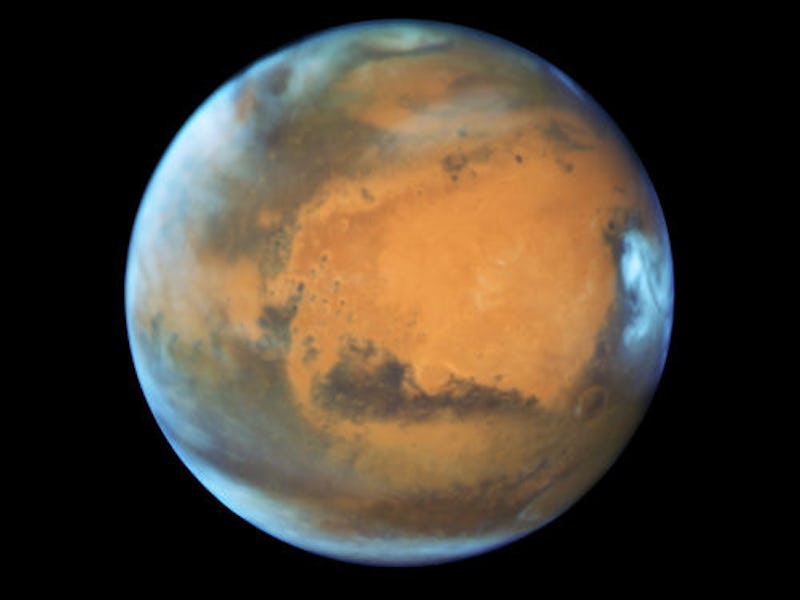Earth and Mars formed from colliding material, new study suggests
Little planetary embryos formed these rocky worlds.

Around 4.6 billion years ago, a young, hot star was born. The Sun formed from a cloud of gas and dust, and over time planetary bodies, including Earth and Mars, came to be.
It’s unlikely that scientists will be able to peer back in time to see how the planets of the Solar System formed, but the process left behind a few clues.
Using meteorites that have traveled from Mars and crash-landed on Earth, a team of scientists has come up with the origin story of these two budding planets. Their findings contradict a previous hypothesis, suggesting that Earth and Mars formed from materials that collided with one another from the inner Solar System.
The study was published Wednesday in the journal Science Advances.
Christoph Burkhardt, a researcher at the University of Münster in Germany and lead author of the new study, studied meteorites for several years before his focus shifted to Mars.
“So we focused first on Mars because there wasn’t a lot of data, but then we realized that it has big implications for planetary formation in general,” Burkhardt tells Inverse.
WHAT’S NEW — The team behind the study analyzed samples from 10 Martian meteorites. Martian meteorites are pieces from the red planet that have traveled through space after impacts on Mars before making their way to Earth.
They looked at the isotopic compositions of titanium, zirconium, and molybdenum in the samples, in addition to measurements from 17 more of Mars’ meteorites. They then compared the composition of these meteorites to meteorites that are thought to have landed on Earth from the inner and outer Solar System.
The inner Solar System contains the terrestrial planets, Mercury, Venus, Earth, and Mars, as well as the asteroid belt; the outer Solar System is made up of Jupiter, Saturn, Uranus, Neptune, their moons, and all points beyond.
By comparing the two groups, the researchers found that the composition of Earth and Mars is more consistent with those meteorites that come from the inner Solar System.
Based on this, the study suggests that the terrestrial planets like Earth and Mars formed from several collisions between material from the inner Solar System, rather than accretion of material from the outer Solar System.
These small bodies formed planetary embryos about the size of the Moon. And these bodies then collided with other bodies, forming the terrestrial planets over a period that lasted millions of years.
The Nakhla meteorite is just one example of several rocks believed to have arrived from Mars.
HERE’S THE BACKGROUND — When it comes to understanding how planets formed in the Solar System, there are two competing theories.
The first suggests that planets formed from the gradual accumulation of pebbles that eventually fused to create a planet. The second suggests that planets formed through a series of collisions between rocky material.
“Both are possible, and we don’t know which one actually formed the planets of the Solar System,” Burkhardt says. “So what we did is we looked at all the data that there is — and not just cherry-picked some that might favor one model over the other — and then tried to integrate all of this together.”
The recent study uses a much larger sample size than previous studies that have tried to resolve this debate.
The competing theory suggests that while the Sun still had an accretion disk of gas and dust surrounding it following its formation, inward drifting pebbles accumulated directly onto preexisting planetary embryos.
This model means that planets like Earth grew very fast.
But by showing that the composition of Earth and Mars is similar to inner Solar System bodies, the new study dismisses the idea that material came from outside the solar system to form these planets.
WHY IT MATTERS — The new findings not only help us understand our own origin story, but also better grasp the formation of other star systems.
“Earth and Mars formed mostly from local material,” Burkhardt says. “And this basically is the reason why Earth is not a super-Earth the way we see in other star systems where a lot of the planets are really big.”
The terrestrial planets in the solar system are relatively small compared to other star systems, and that may be due to Jupiter. Jupiter may have also formed early on, and blocked incoming material from fusing with the planetary embryos.
“We are sheltered by Jupiter, and the fact that our planetary system looks the way it does today is owed to the early formation of Jupiter,” Burkhardt says. “For other star systems that might be quite different when they do not have a Jupiter to block things.”
Abstract — Two fundamentally different processes of rocky planet formation exist, but it is unclear which one built the terrestrial planets of the solar system. They formed either by collisions among planetary embryos from the inner solar system or by accreting sunward-drifting millimeter-sized “pebbles” from the outer solar system. We show that the isotopic compositions of Earth and Mars are governed by two-component mixing among inner solar system materials, including material from the innermost disk unsampled by meteorites, whereas the contribution of outer solar system material is limited to a few percent by mass. This refutes a pebble accretion origin of the terrestrial planets but is consistent with collisional growth from inner solar system embryos. The low fraction of outer solar system material in Earth and Mars indicates the presence of a persistent dust-drift barrier in the disk, highlighting the specific pathway of rocky planet formation in the solar system.
This article was originally published on